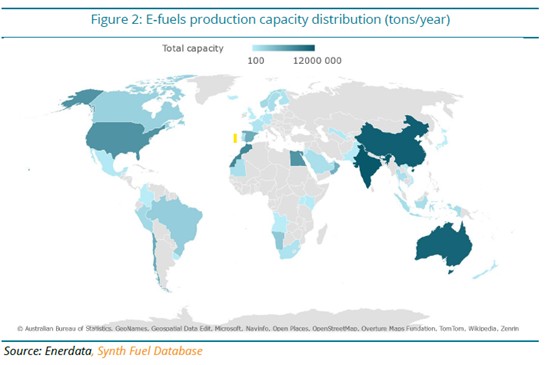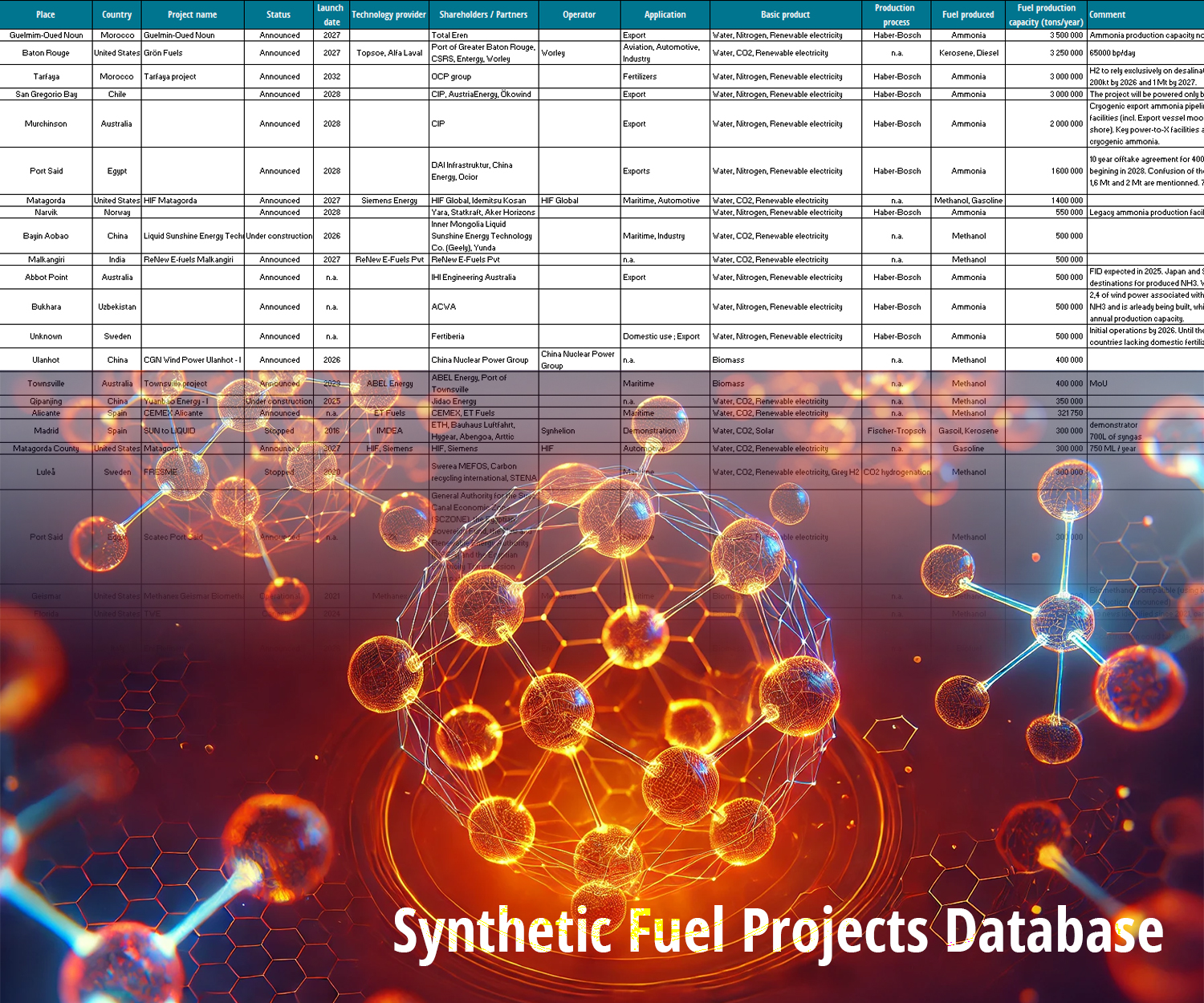- Update
-
- Format
-
Excel
- Delivery
-
Between 1 and 2 working days
Buy Synthetic Fuel Projects Database
Price without VAT. Depending on your statute and location, VAT might be applicable. Get in touch with us for more information.
Overview
The decarbonisation of various transport sectors has led to the development and deployment of new technologies, particularly synthetic fuels. As a result, numerous production projects are emerging across the globe. The majority of these projects have been announced recently and are therefore still in an early stage of development.
This document is a database of green synthetic fuel production projects identified by Enerdata globally. It shows a representative sample of major synthetic fuel projects . At the heart of our database are advanced projects centered around next-generation biofuels and e-fuels, such as ammonia, methanol, and e-kerosene. These innovative solutions are gaining momentum, particularly in sectors like maritime and aviation, where reducing emissions is crucial for meeting global climate targets.
So-called e-fuels are molecules that are produced by combining renewable hydrogen, obtained by water electrolysis using low-carbon electricity, and a carbon containing molecule most of the time (carbon dioxide or monoxide), or nitrogen in the case of e-ammonia. E-fuels are therefore largely linked to hydrogen production and depend on the evolution of its market.
Biofuels are produced through processes like fermentation, and pyrolysis, depending on the type of fuel. The main feedstocks include crops such as corn, sugarcane, and soybeans, as well as waste oils, algae, and cellulose-rich biomass. These methods convert raw materials into bioethanol, biodiesel, or advanced biofuels.
E-fuels production capacity distribution

*Projects capacity announced or under construction
Source: Enerdata Synthetic Fuel Projects Database
By 2030, according to company announcements, Synfuels annual production could exceed 200 million tons (Mt) with 80 Mt for e-fuels and 120 MT for advanced biofuels. Production capacities are concentrated in a few key countries, including China, Australia, Egypt, India, the USA, and several European countries. Its production will be enabled by various technologies, with two main ones being the Haber-Bosch and Fischer-Tropsch processes.
Different type of players are involved in these projects:
- Mature large companies from the petrochemicals sector such as Total, Shell, or Exxon, that are project developers and/or technology providers.
- Small pure-player innovation companies with specific expertise in CCUS or e-Fuel production technologies like HIF Global, Synhelion, Infinium, or Carbon Recycling International.
- And last but not least, the operators of aircraft and ships fleets (e.g. Maersk, Lufthansa, KLM …) that are off-takers of the projects.
Moreover, one of the key insights of this report is the status of the synfuels projects. In fact, nearly 80% of them have not yet reached the Final Investment Decision (FID). This highlights significant uncertainty regarding the development of these technologies.
The report's insights into key manufacturers, their capacities, and global installation status provide invaluable guidance for investors, policymakers, and industry stakeholders seeking to navigate the evolving landscape of synfuel production.
- E-Fuels and biofuels capacity, globally and regionally
- Main synfuels project developer
- A synthetic fuel database of more than 300 projects
- Up-to-date project status
Key Features
- World-wide coverage
- Identification of key market players in e-fuels and bio-fuels value chain
- Analysis of the status of Synfuels projects
- Information on the potential applications (e.g. maritime, aviation)
- Excel delivery including:
- Location
- Country
- Synfuel project name
- Status
- Announcement date
- Launch date
- Synfuel technology provider
- Shareholders / Partners
- Operator
- User
- FID
- Application
- Basic product
- Production process
- Fuel produced
- Fuel production capacity (tons/year)
- Maximum production capacity (tons/year)
- Sources
 Energy and Climate Databases
Energy and Climate Databases Market Analysis
Market Analysis